Why Forms Reviews Are Important to the Organization |
| By Ray Killam |
|
|
 We live in a world of change. Business processes change. Procedures change. Regulatory and legal requirements change. Keeping up with all this change can challenge even the best of us. Forms are like small children–leave them alone and they will get into trouble. That’s why a very important function of forms management is conducting regular reviews for each form in the organization. With no regular reviews, forms get out of date quickly. Reviews are generally conducted when a forms project is initiated, upon reprint of a paper form, when scheduled, upon specific request and during a macro review of the forms population. Conducting reviews Forms projects: Each time a forms project is initiated, a review of the existing form becomes a part of the project. Checking the form history file or database for any notes or comments and checking with the form owner is among the first steps performed. Reprint: An ideal time to conduct a review is when a form is ready for reprint. This review is generally simple and straightforward. An email is sent to the form owner asking if the form is still active and if any changes are needed or anticipated. If changes are needed, or if the form is no longer active, a forms project is established. The review status is then updated when the project is completed. If the form is active and no changes are required, the reprint project is established and the review is complete. The review status is then updated in the database. As we convert more forms to electronic format, fewer reprint reviews are scheduled. Scheduled: We recommend that each form be reviewed at least every 12 to 18 months, depending on the nature of the form and its usage. The established review date is recorded in the database. Each month, reports are generated that list forms requiring reviews in the upcoming month and that show the status of all open reviews. Reviews can be for an individual form or for a group of related forms (batch processing). Scheduled reviews can be a simple email (described above under reprints) or they can encompass a short questionnaire. The email or questionnaire is sent to the form owner. If there are no changes required, the review date is updated in the database, and the review is complete. If changes are required, or if the form is no longer active, a form project is initiated, and the review date is updated upon project completion. Most forms will require a scheduled review date. They generally do not require much time to complete but do provide an important check that helps keep the forms population fresh and current. Upon request (ad hoc) reviews: Many events can trigger an ad hoc review, including legal changes, regulatory changes, policy changes, acquisitions, reorganizations, divestitures, major software system changes and strategic planning processes. Ad hoc reviews may be set up as a non-forms project or as a multi-forms project and tracked to completion. Such reviews frequently result in additional, form-specific projects. Macro reviews: Macro reviews are generally initiated by forms management and are set up as a non-forms project. The purpose of the review is to examine the entire forms population or a specified segment of the forms population, looking for improvement opportunities. Get curious, and look at your forms from varying viewpoints. Run queries on a variety of parameters, such as specifications, business systems, form type, form owner and others. When an opportunity is identified, a forms project is established (generally a batch project involving multiple forms). We recommend a macro analysis be conducted every one to two years. Keeping track Any organization with a large forms population will need a database that contains fields for storing information related to reviews, including "Last Review Date," "Next Review Date," "Review Type," "Reviewed By" and more (see examples below). Queries and reports can help keep the process under control and can speed up and simplify the review process. In addition, resource assignments and time tracking, which are added to results reporting, can help demonstrate the cost savings achieved by an aggressive forms review process. 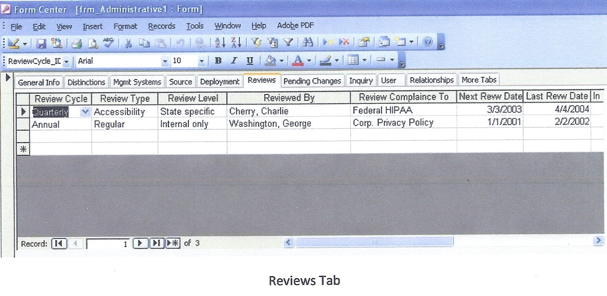 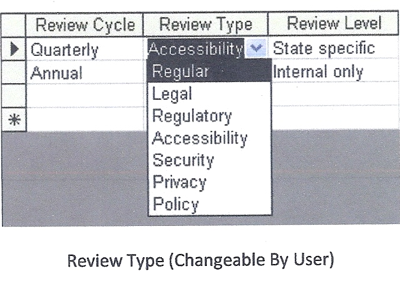 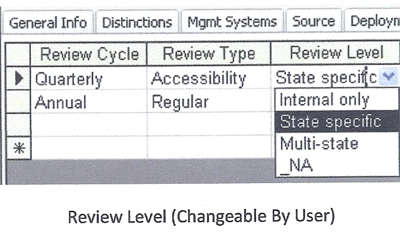 Conducting reviews Many reviews are conducted by using a standard email, addressed to the form owner. When the response is received in forms management, a project may be established (revision or discontinuance). If no further action is required, the database is updated, and the review is complete. 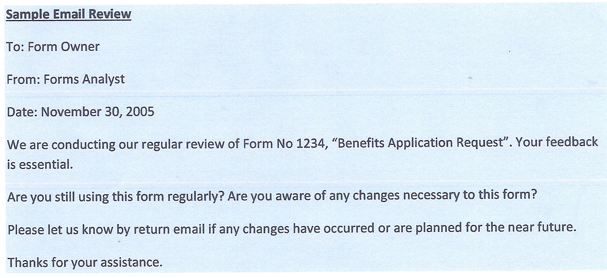 The next level of review uses a standard questionnaire that is sent to the form owner. It is the forms analyst’s judgment when to use the questionnaire, though guidelines may be established based on usage, business systems involved, complexity or other criteria. 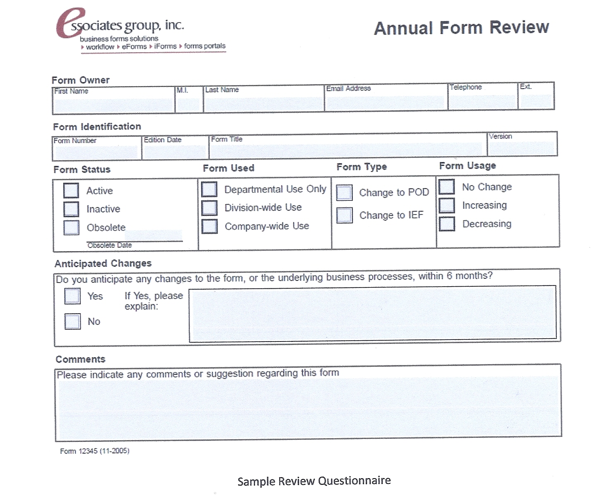 The returned questionnaire requires an analyst review of the responses. If no action is required, the database is updated, and the review is complete. If additional action is required, a project is established. The review is complete upon completion of the project. Some form reviews result in an immediate project. This frequently occurs when the database contains information about changes required “on next review” or when forms management personnel are aware of problems with the form. Other reviews can be more extensive, requiring deeper analysis projects to examine the form’s performance in the business process that it supports. If regular reviews are not conducted, the risk to the organization can increase significantly. Ray Killam is the president of Essociates Group, a firm that provides forms training and consulting services. Contact him at rkillam@essociatesgroup.com. |
